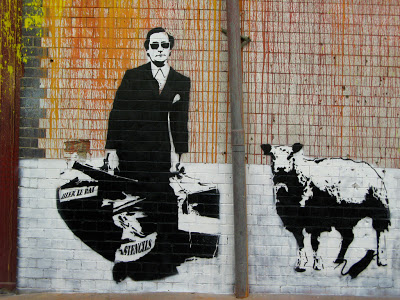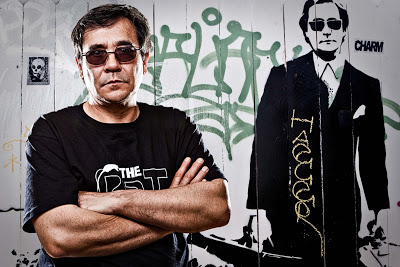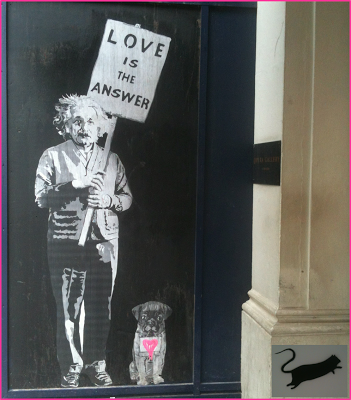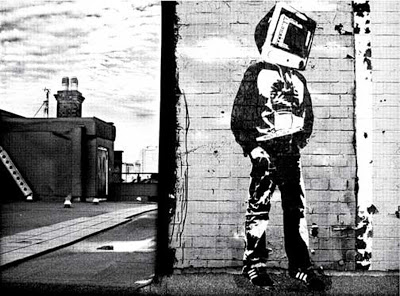Street Arts

His art transcended barrier after barrier, always one step ahead of originality’s curve. Everymen melted into pathos, taboos were broken, the halos were rattled atop cultural paragons and sepia monochromes breathed life into the rat race. Piercing figures bursting out of cold concrete bathed in the light of life, and the blight of strife. He fundamentally changed the way we see art and ourselves and a few paragraphs could never do it justice. So over to the man himself with immense respect.
What was the state of public art when you were coming of age?
In 1968 we couldn’t really talk about public art in the sense we understand it today - the only public art in Paris would have been large murals with heavy official backing. It started more during the seventies. But I don’t really relate to or particularly like huge painted facades. I just don’t think it’s that interesting in a city – it’s way too big and impersonal and certainly doesn’t touch me personally. I think the real question is the state of art in 1968, a momentous year in France that saw something close to a revolution with huge student protests and a vast number of strikes. At the time, the students of the Beaux Arts school of Paris created workshops where they did revolutionary posters to stick all over Paris throughout the month of May. I was 17 years old, and when I saw them, I was genuinely moved by them. It was mostly screen printed black and white posters with very strong messages, and they were my first insight into what a revolution could be. They definitely left their mark on me and they were the artistic reflection of a tumultuous, exciting time. Beyond that, I’d say street art didn’t exist in Paris in any form apart from the stock murals. It existed in the US, it existed in New York but it didn’t exist in France.

I don’t think London had any either. I mean during the 70’s there was maybe one or two artists that would work in the street but that’s about it. I used to go to London during the 70’s and I don’t remember seeing any public art - and there was no graffiti in the streets of Berlin, in Italy or in France. It’s really a movement that started in the US, from New York and that arrived in Europe during the 80’s but not before. I can’t really talk about public art unless you call public art the statues they put in front of schools - state driven and entrenched in an agenda. When I speak about public art, what interests me is an art that is free, a bit rebellious and forbidden, a forbidden art that is done secretly in the street.
Actually there was a form of graffiti back then but it tended to be heavily political. In France there has always been a great tradition of political graffiti throughout the centuries – where people would secretly air their views on the state, the king, the president or their neighbour all over a wall. When I was a child and the Algerian war of independence was raging over the embers of colonialism, I remember all kinds of messages and slogans appearing all over the city from both sides – be it ‘French Algeria” or “Algeria to the Algerians”.

Stencils were originally a political communication and propaganda tool. How aware were you of that legacy when you started stenciling and how conscious was that connection?
I was absolutely aware and the connection was conscious. I discovered stencils at the beginning of the sixties during a trip to Italy with my parents. While we were in Padova, I remember seeing a stencilled portrait of Mussolini on the city walls. It wasn’t a new or even a recent thing - it was a relic of the Second World War. And it was actually very well done - a profile of Mussolini wearing a helmet. I was maybe something like eleven or twelve and I asked my father why people did that, why did people paint directly on the wall, why they didn’t use posters - I knew posters but this I had never seen before. My dad answered it was propaganda, and that the fascists did it. During the Second World War, fascists did all their propaganda using stencils and they did it all with paint soaked rollers, as spray paint didn’t exist back then...

- Tik Tok Clean The Block By Dirk Robertson
“I wish I hadn’t written my name so large.” She has her back to me, scrubbing the wall of the public convenience, in the park. Two other girls are doing the same thing. They are sound. I like them, They’re not gangsters, crooks or nutters....
- Lsd Magazine Interviews Iranian Street Artists - Icy & Sot
If you peer past the stereotypes, endless propaganda on both sides of the divide and the dark theocratic veil of Iran, it won’t be long before you touch both the not so silent underground and the extraordinarily nuanced pathos of Icy and Sot’s art....
- Lsd Magazine Interviews - Michael De Feo (issue 5)
From the hustling, bustling, innocence rustling streets of New York City to the rainbow nations of the world, Michael de Feo’s primal aesthetic of the simplicity of organic perceptions has taken root in the recesses of global urban consciousness. The...
- Lsd Magazine Interviews Graffiti Legend Mear One - Issue 4
If the apogee of the graffiti artform is the hijacking of commercially numb public space to question, provoke and elevate the viewer into a higher state of reflective consciousness then Mear One is spraying up the cutting edge. Unifying the psychedelic...
- Streetartsf.com - Interview
http://streetartsf.com/interview/yola/ ARTIST INTERVIEW: YOLA By Street Art SF Team on October 03, 2012 Also what is really cool is that other people start tagging your work, and your picture gets another life, a new context, and it starts to get...
Street Arts
LSD Magazine interviews Blek le Rat (issue 9)

His art transcended barrier after barrier, always one step ahead of originality’s curve. Everymen melted into pathos, taboos were broken, the halos were rattled atop cultural paragons and sepia monochromes breathed life into the rat race. Piercing figures bursting out of cold concrete bathed in the light of life, and the blight of strife. He fundamentally changed the way we see art and ourselves and a few paragraphs could never do it justice. So over to the man himself with immense respect.
What was the state of public art when you were coming of age?
In 1968 we couldn’t really talk about public art in the sense we understand it today - the only public art in Paris would have been large murals with heavy official backing. It started more during the seventies. But I don’t really relate to or particularly like huge painted facades. I just don’t think it’s that interesting in a city – it’s way too big and impersonal and certainly doesn’t touch me personally. I think the real question is the state of art in 1968, a momentous year in France that saw something close to a revolution with huge student protests and a vast number of strikes. At the time, the students of the Beaux Arts school of Paris created workshops where they did revolutionary posters to stick all over Paris throughout the month of May. I was 17 years old, and when I saw them, I was genuinely moved by them. It was mostly screen printed black and white posters with very strong messages, and they were my first insight into what a revolution could be. They definitely left their mark on me and they were the artistic reflection of a tumultuous, exciting time. Beyond that, I’d say street art didn’t exist in Paris in any form apart from the stock murals. It existed in the US, it existed in New York but it didn’t exist in France.

I don’t think London had any either. I mean during the 70’s there was maybe one or two artists that would work in the street but that’s about it. I used to go to London during the 70’s and I don’t remember seeing any public art - and there was no graffiti in the streets of Berlin, in Italy or in France. It’s really a movement that started in the US, from New York and that arrived in Europe during the 80’s but not before. I can’t really talk about public art unless you call public art the statues they put in front of schools - state driven and entrenched in an agenda. When I speak about public art, what interests me is an art that is free, a bit rebellious and forbidden, a forbidden art that is done secretly in the street.
Actually there was a form of graffiti back then but it tended to be heavily political. In France there has always been a great tradition of political graffiti throughout the centuries – where people would secretly air their views on the state, the king, the president or their neighbour all over a wall. When I was a child and the Algerian war of independence was raging over the embers of colonialism, I remember all kinds of messages and slogans appearing all over the city from both sides – be it ‘French Algeria” or “Algeria to the Algerians”.

Stencils were originally a political communication and propaganda tool. How aware were you of that legacy when you started stenciling and how conscious was that connection?
I was absolutely aware and the connection was conscious. I discovered stencils at the beginning of the sixties during a trip to Italy with my parents. While we were in Padova, I remember seeing a stencilled portrait of Mussolini on the city walls. It wasn’t a new or even a recent thing - it was a relic of the Second World War. And it was actually very well done - a profile of Mussolini wearing a helmet. I was maybe something like eleven or twelve and I asked my father why people did that, why did people paint directly on the wall, why they didn’t use posters - I knew posters but this I had never seen before. My dad answered it was propaganda, and that the fascists did it. During the Second World War, fascists did all their propaganda using stencils and they did it all with paint soaked rollers, as spray paint didn’t exist back then...

READ LSD MAGAZINE ISSUE 9 - FREE (Below)
READ FULL INTERVIEW HERE IN ISSUE 9
Open publication - Free publishing - More culture
- Tik Tok Clean The Block By Dirk Robertson
“I wish I hadn’t written my name so large.” She has her back to me, scrubbing the wall of the public convenience, in the park. Two other girls are doing the same thing. They are sound. I like them, They’re not gangsters, crooks or nutters....
- Lsd Magazine Interviews Iranian Street Artists - Icy & Sot
If you peer past the stereotypes, endless propaganda on both sides of the divide and the dark theocratic veil of Iran, it won’t be long before you touch both the not so silent underground and the extraordinarily nuanced pathos of Icy and Sot’s art....
- Lsd Magazine Interviews - Michael De Feo (issue 5)
From the hustling, bustling, innocence rustling streets of New York City to the rainbow nations of the world, Michael de Feo’s primal aesthetic of the simplicity of organic perceptions has taken root in the recesses of global urban consciousness. The...
- Lsd Magazine Interviews Graffiti Legend Mear One - Issue 4
If the apogee of the graffiti artform is the hijacking of commercially numb public space to question, provoke and elevate the viewer into a higher state of reflective consciousness then Mear One is spraying up the cutting edge. Unifying the psychedelic...
- Streetartsf.com - Interview
http://streetartsf.com/interview/yola/ ARTIST INTERVIEW: YOLA By Street Art SF Team on October 03, 2012 Also what is really cool is that other people start tagging your work, and your picture gets another life, a new context, and it starts to get...
